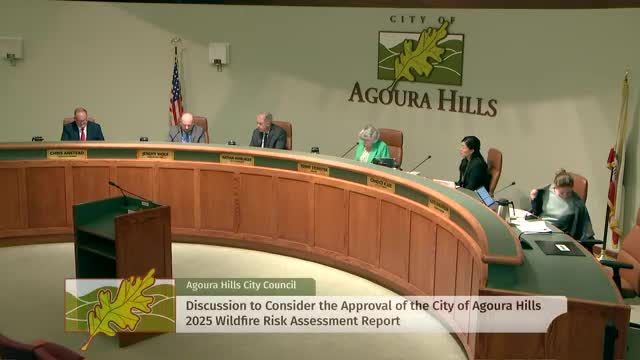Agoura Hills council approves 2025 Community Wildfire Risk Assessment, paving way for CWPP
October 23, 2025 | Agoura Hills, Los Angeles County, California
This article was created by AI summarizing key points discussed. AI makes mistakes, so for full details and context, please refer to the video of the full meeting. Please report any errors so we can fix them. Report an error »

Agoura Hills City Council unanimously approved the city’s 2025 Community Wildfire Risk Assessment (CWRA), a scientific, spatial analysis staff said is the first step toward a Community Wildfire Protection Plan and future grant‑funded mitigation projects.
City staff and consultant Jensen Hughes presented the assessment, which models fire hazard and frequency across the city using fuel, topography and wind data and overlays those results with community exposures — homes, roads, critical infrastructure and natural resources. David Kerr of Jensen Hughes described the methods and key findings: Liberty Canyon and the eastern portions of the city show the highest projected hazard and fire flow frequency, and multiple “fingers” of wildland fuels can channel fires toward developed neighborhoods.
Kerr said the analysis used a conservative weather envelope (the 97th percentile of adverse conditions) and cited 30 years of ignition history to model likely fire paths and flame lengths. He described specific vulnerabilities the team observed on a November site visit: limited access roads in parts of Chesebro, stretches of dense vegetation near residences and parkland, and older housing stock built before WUI standards existed. “One thing that is static around here is our weather and climate system,” Kerr said, noting the region’s Mediterranean climate and wind‑driven fire behavior.
Public comment reinforced urgency. Jay Krecher, who worked on outreach related to the CWRA, told the council that live fuel moisture and drought indicators remain poor and urged expedited movement to the CWPP, noting many residents reported not feeling prepared and lacking awareness of county evacuation alerts.
The CWRA includes a list of recommendations grouped by topic: public education and defensible‑space outreach; interagency cooperation on fuels management; targeted fuel‑reduction projects along identified high‑risk flow paths and egress routes; evacuation‑zone maps and improved communications redundancy; and pathways to unlock state and federal grant funding. Staff said the city already has grant funds allocated to begin the CWPP and that the CWRA will be used to prioritize projects and create the spatially specific treatment and project list: “This report will unlock future state and grant funding that will be available related to wildfire mitigation grants,” staff said.
The council voted 4‑0 to approve the CWRA and directed staff to proceed with the CWPP process. Council members stressed urgency and public engagement as priorities. Mayor Sylvester said the CWRA is a necessary first step and that the CWPP will be where the city and community prioritize projects and funding.
City staff and consultant Jensen Hughes presented the assessment, which models fire hazard and frequency across the city using fuel, topography and wind data and overlays those results with community exposures — homes, roads, critical infrastructure and natural resources. David Kerr of Jensen Hughes described the methods and key findings: Liberty Canyon and the eastern portions of the city show the highest projected hazard and fire flow frequency, and multiple “fingers” of wildland fuels can channel fires toward developed neighborhoods.
Kerr said the analysis used a conservative weather envelope (the 97th percentile of adverse conditions) and cited 30 years of ignition history to model likely fire paths and flame lengths. He described specific vulnerabilities the team observed on a November site visit: limited access roads in parts of Chesebro, stretches of dense vegetation near residences and parkland, and older housing stock built before WUI standards existed. “One thing that is static around here is our weather and climate system,” Kerr said, noting the region’s Mediterranean climate and wind‑driven fire behavior.
Public comment reinforced urgency. Jay Krecher, who worked on outreach related to the CWRA, told the council that live fuel moisture and drought indicators remain poor and urged expedited movement to the CWPP, noting many residents reported not feeling prepared and lacking awareness of county evacuation alerts.
The CWRA includes a list of recommendations grouped by topic: public education and defensible‑space outreach; interagency cooperation on fuels management; targeted fuel‑reduction projects along identified high‑risk flow paths and egress routes; evacuation‑zone maps and improved communications redundancy; and pathways to unlock state and federal grant funding. Staff said the city already has grant funds allocated to begin the CWPP and that the CWRA will be used to prioritize projects and create the spatially specific treatment and project list: “This report will unlock future state and grant funding that will be available related to wildfire mitigation grants,” staff said.
The council voted 4‑0 to approve the CWRA and directed staff to proceed with the CWPP process. Council members stressed urgency and public engagement as priorities. Mayor Sylvester said the CWRA is a necessary first step and that the CWPP will be where the city and community prioritize projects and funding.
View full meeting
This article is based on a recent meeting—watch the full video and explore the complete transcript for deeper insights into the discussion.
View full meeting
